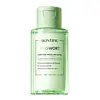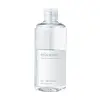What's inside
What's inside
 Key Ingredients
Key Ingredients

No key ingredients
 Benefits
Benefits

 Concerns
Concerns

 Ingredients Side-by-side
Ingredients Side-by-side

Water
Skin ConditioningPEG-7 Glyceryl Cocoate
EmulsifyingDipropylene Glycol
HumectantPEG-6 Caprylic/Capric Glycerides
EmulsifyingArtemisia Vulgaris Extract
Skin ConditioningAllantoin
Skin ConditioningCentella Asiatica Extract
CleansingCitric Acid
BufferingEthylhexylglycerin
Skin ConditioningCeramide AP
Skin ConditioningCeramide As
Skin ConditioningDipotassium Glycyrrhizate
HumectantCeramide Ns
Skin ConditioningCeramide Ng
Skin ConditioningCeramide EOP
Skin ConditioningCeramide NP
Skin ConditioningDisodium EDTA
Potassium Benzoate
PreservativeBifida Ferment Filtrate
Skin ConditioningWater, PEG-7 Glyceryl Cocoate, Dipropylene Glycol, PEG-6 Caprylic/Capric Glycerides, Artemisia Vulgaris Extract, Allantoin, Centella Asiatica Extract, Citric Acid, Ethylhexylglycerin, Ceramide AP, Ceramide As, Dipotassium Glycyrrhizate, Ceramide Ns, Ceramide Ng, Ceramide EOP, Ceramide NP, Disodium EDTA, Potassium Benzoate, Bifida Ferment Filtrate
Water
Skin ConditioningPropanediol
SolventPolyglyceryl-4 Caprate
Emulsifying1,2-Hexanediol
Skin ConditioningPolyglyceryl-6 Caprylate
EmulsifyingPolyglyceryl-6 Ricinoleate
EmulsifyingPolyglyceryl-3 Cocoate
EmulsifyingButylene Glycol
HumectantBetaine
HumectantPanthenol
Skin ConditioningErythritol
HumectantCentella Asiatica Extract
CleansingHouttuynia Cordata Extract
Skin ConditioningIllicium Verum Fruit Extract
PerfumingCaprylyl Glycol
EmollientAllantoin
Skin ConditioningDisodium EDTA
Citric Acid
BufferingSodium Citrate
BufferingWater, Propanediol, Polyglyceryl-4 Caprate, 1,2-Hexanediol, Polyglyceryl-6 Caprylate, Polyglyceryl-6 Ricinoleate, Polyglyceryl-3 Cocoate, Butylene Glycol, Betaine, Panthenol, Erythritol, Centella Asiatica Extract, Houttuynia Cordata Extract, Illicium Verum Fruit Extract, Caprylyl Glycol, Allantoin, Disodium EDTA, Citric Acid, Sodium Citrate
 Reviews
Reviews

Ingredients Explained
These ingredients are found in both products.
Ingredients higher up in an ingredient list are typically present in a larger amount.
Allantoin is a soothing ingredient known for its protective and moisturizingg properties. Because of this, it is often added to products with strong active ingredients.
Studies show higher concentrations of this ingredient can promote wound healing.
Though it can be derived from the comfrey plant, allantoin is produced synthetically for cosmetic products to ensure purity.
Learn more about AllantoinCentella Asiatica Extract (Centella) is derived from an herb native to Southeast Asia. It is famous for its anti-inflammatory and soothing properties.
Centella is rich in antioxidants and amino acids, such as Madecassic Acid and Asiaticoside.
Studies show the compounds in centella help with:
The combination of all these properties makes centella effective at soothing, hydrating, and protecting the skin.
Other great components of centella include Vitamin A, vitamin C, several B vitamins, and Asiatic Acid.
Fun fact: Centella has been used as a medicine and in food for many centuries. As a medicine, it is used to treat burns, scratches, and wounds.
Learn more about Centella Asiatica ExtractCitric Acid is an alpha hydroxy acid (AHA) naturally found in citrus fruits like oranges, lemons, and limes.
Like other AHAs, citric acid can exfoliate skin by breaking down the bonds that hold dead skin cells together. This helps reveal smoother and brighter skin underneath.
However, this exfoliating effect only happens at high concentrations (20%) which can be hard to find in cosmetic products.
Due to this, citric acid is usually included in small amounts as a pH adjuster. This helps keep products slightly more acidic and compatible with skin's natural pH.
In skincare formulas, citric acid can:
While it can provide some skin benefits, research shows lactic acid and glycolic acid are generally more effective and less irritating exfoliants.
Most citric acid used in skincare today is made by fermenting sugars (usually from molasses). This synthetic version is identical to the natural citrus form but easier to stabilize and use in formulations.
Read more about some other popular AHA's here:
Learn more about Citric AcidDisodium EDTA plays a role in making products more stable by aiding other preservatives.
It is a chelating agent, meaning it neutralizes metal ions that may be found in a product.
Disodium EDTA is a salt of edetic acid and is found to be safe in cosmetic ingredients.
Learn more about Disodium EDTAWater. It's the most common cosmetic ingredient of all. You'll usually see it at the top of ingredient lists, meaning that it makes up the largest part of the product.
So why is it so popular? Water most often acts as a solvent - this means that it helps dissolve other ingredients into the formulation.
You'll also recognize water as that liquid we all need to stay alive. If you see this, drink a glass of water. Stay hydrated!
Learn more about Water